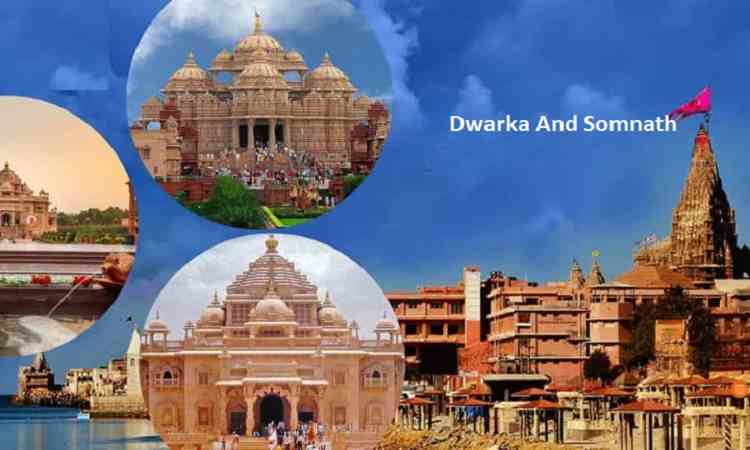Last Updated on November 27, 2023
The pilgrimage route from Dwarka to Somnath is of great significance in Western India celebrated for the historical and religious prominence of both destinations. Somnath, a revered site in Gujarat, not only serves as a pilgrimage center but also attracts tourists due to its accessibility through a well-connected road network and various transportation modes. The most convenient way to travel from Dwarka to Somnath is by road, facilitated by numerous taxis, cabs, and car rental services connecting these two sacred places.
Dwarka to Somnath Journey
Steeped in legend, Dwarka is believed to have been founded by Lord Krishna on the banks of the Gomti River after leaving Mathura. Somnath, with attractions like Panch Pandav Gufa, Somnath Mahadev Mandir, and Triveni Sangam, holds special significance for Hindu devotees. This article explores the distance between Dwarka and Somnath, available transportation options, and the spiritual essence of this pilgrimage.
Distance between Dwarka and Somnath
The road distance between Dwarka and Somnath is approximately 235 kilometers, with an aerial distance of about 211 kilometers. Dwarka, an ancient kingdom, contrasts with Somnath, known for the Somnath Temple, one of the twelve Jyotirlingas in India.
Travel Options from Dwarka to Somnath
By Car: The most common and convenient mode of travel is by road, offering a scenic drive through Gujarat’s picturesque landscape. The journey takes around 4 to 5 hours, providing a comfortable experience.
By Bus: Robust public transportation options include buses operated by the Gujarat State Road Transport Corporation (GSRTC). The journey takes approximately 8 to 9 hours, making it an affordable choice for pilgrims and travelers.
By Taxi/Cab: Hiring a private taxi or cab is a preferred option for many, allowing flexibility in exploring the route at one’s own pace.
By Train: Although there is no direct train connectivity between Dwarka and Somnath, travelers can opt for a train to Veraval, the nearest railway station, and then cover the remaining distance by road or local transport.
The Significance of Dwarka and Somnath
While the road distance between Dwarka and Somnath is traversable, the journey holds profound religious significance for devotees. Dwarka is believed to be where Lord Krishna established his kingdom and is recognized as one of the Char Dham (four sacred abodes) in Hindu mythology. Drawing thousands of devotees, the main attraction in Dwarka is the Dwarkadhish Temple.

Somnath is renowned for the Somnath Temple, which carries great religious importance in the Hindu faith and is often referred to as the “Eternal Shrine.” Despite being destroyed by foreign invasions, the temple has been rebuilt and stands today as a symbol of faith and resilience.
There are also some fantastic stops along the way that you can visit, including:
1. Bhadkeshwar Mahadev Temple: Situated on a peninsula extending into the ocean, this serene Shiva temple is popular for its sunset views.
2. Shree Dwarkadhish Temple: A landmark Hindu temple dedicated to Lord Krishna, known for its elaborate tiered main shrine dating back to 400 BC,
3. Shri Krishna Mandir, Dwarka: This riverside Hindu temple is a place where worshippers come for religious significance, bathing, and floating diya candles on the water. Visitors can also take a local boat to explore Bet Dwarka and the Old Temple of Krishna.
4. Sudama Setu: Providing a breathtaking view of the temple from a distance, this bridge offers a spiritual experience and a chance to visit the Gujarat coastline as part of the overall tour plan.
5. Gopi Talav Theertham: Considered among significant places in Hinduism, it is believed that this is where the Gopis of Vrindavan met Lord Krishna for the last time before he set off for Dwarka.
6. Shri Nageshvar Jyotirling: A massive temple honoring Lord Shiva, one of the 12 Jyotirlingas in India
7. Mahatma Gandhi’s Birthplace (Kirti Mandir): Witness the three-story home of the famous freedom fighter, born here in 1869, now converted into a museum showcasing the history of his life.
8. Sudama Temple, Porbandar: A tranquil spot dedicated to a devotee of Lord Krishna is known for its calm surroundings.
Best time to Visit Dwarka and Somnath
The most suitable period to avail of the Dwarka Somnath Tour Package is from October to March, encompassing the autumn and winter months. This timeframe ensures pleasant and comfortable weather for outdoor exploration. Avoiding travel during the peak summer season is advisable due to the intense heat and humidity, which make outings uncomfortably hot. Similarly, it is recommended to refrain from traveling to Gujarat during the peak monsoon months, considering the state’s location on the western edge of the country and its proximity to the Arabian Sea.
Frequently Asked Questions (FAQs):
Q.1 Can I visit both Dwarka and Somnath on a Single trip?
Ans. Yes, it is common and considered auspicious to visit both locations on one journey.
Q.2 When is the optimal time to journey from Dwarka to Somnath?
Ans. The best time is during the autumn-winter months of October through March for a comfortable and pleasant experience.
Q.3 What considerations should I consider when visiting Dwarka and Somnath?
Ans. Visitors should respect local religious sensibilities, dress modestly, and carry essentials.
Q.4 Why Undertake the Journey from Dwarka to Somnath?
Ans. The pilgrimage is undertaken for blessings, spiritual solace, and to explore the cultural and historical heritage of Gujarat.
Q.5 What Kind of Food Is Famous in Somnath?
Ans. Authentic Gujarati delicacies such as Fafda, Sev, Chaas, Ghevar, and more are recommended for an authentic experience.
Embarking on the journey from Dwarka to Somnath, spanning 235 kilometers, offers not just a physical distance but a profound experience of faith, devotion, and cultural exploration. Whether choosing a road, bus, taxi, or a combination of road and rail, the pilgrimage provides a rich and meaningful encounter for devotees and travelers alike.
